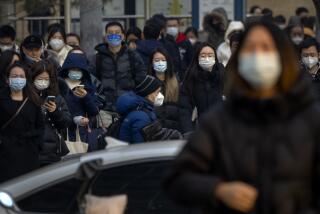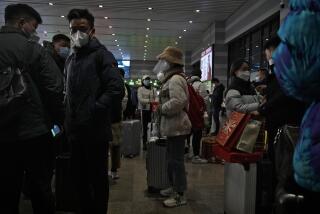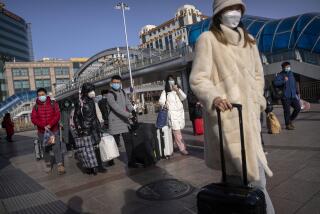As new threats emerge in coronavirus outbreak, China voices optimism

- Share via
BEIJING — Chinese health officials expressed new optimism Thursday over the deadly coronavirus outbreak while authorities in South Korea’s fourth-largest city urged residents to hunker down as fears nagged communities far from the illness’ epicenter.
The confidence voiced by China’s government came as it reported a reduced number of new infections. But doubts remained about the true trajectory of the epidemic as China again changed its method of counting and new threats emerged outside the country.
“The downward trend will not be reversed,” said Ding Xiangyang, deputy chief secretary of the State Council and a member of the central government’s supervision group.
Meanwhile, countries around the world continued to grapple with the outbreak’s ripple effects. The latest front in the widening global fight against the coronavirus, also called COVID-19, emerged in Daegu, South Korea, where the city’s 2.5 million residents were urged to stay inside, wearing masks even indoors to stem further infection.
Mayor Kwon Young-jin made a nationally televised appeal for those preventative measures, warning that a rash of new cases could overwhelm the health system. He pleaded for help from the country’s central government.
Daegu and surrounding towns reported 35 new cases of the coronavirus on Thursday.
The flare-up came more than 900 miles from COVID-19’s epicenter across the Yellow Sea in China’s Hubei province and its capital of Wuhan, a sign of the risks that the virus potentially poses to communities across the region and beyond.
“Everything that is not known about this is causing concern,” said Dr. David Heymann, a professor of infectious disease epidemiology at the London School of Hygiene and Tropical Medicine.
Though all but about 1,000 of more than 75,000 reported cases of COVID-19 have been recorded in China, scattered cases have erupted elsewhere.
Iran announced three more infections Thursday, a day after the country’s state-run news agency, IRNA, reported its first two deaths stemming from the virus. In addition, South Korea reported its first fatality and Japan said two former passengers of the Diamond Princess cruise ship had died of the illness, bringing the death toll there to three.
Other deaths confirmed by the World Health Organization outside mainland China include two in Hong Kong and one each in France, the Philippines and Taiwan.
The trajectory of the outbreak remained clouded by China’s zigzagging daily reports of new cases and shifting ways of tallying them.
The number of new cases in China declined again Thursday, to 394, a notable shift from the 1,749 figure released a day earlier. An additional 114 deaths in China were linked to the virus.
But those statistics came after yet another change in how cases are counted.
Last week, China’s National Health Commission said officials in Hubei would record new infections without waiting for laboratory test results, relying instead on doctors’ diagnoses and lung imaging. On Thursday, though, it returned to its prior way of counting, a decision sure to aggravate observers who say consistency is key to understanding COVID-19’s path.
The health commission said it was reducing its count of infections by 279 after lab tests found they had wrongly been included in the tally.
Feng Yong, an official for health matters at the Chinese diplomatic mission in Geneva, said the reason for the reversal was that the country’s laboratory capacity had improved dramatically so all patients can now be tested.
Cities in Hubei with a combined population of more than 60 million have been under lockdown since the Lunar New Year holiday. Authorities halted nearly all transportation and movement except for quarantine efforts, medical care, and delivery of food and basic necessities. “Wartime” measures were implemented in some places, with residents prevented from even leaving their apartments.
The stringent moves have followed public fury over Hubei authorities’ handling of the outbreak at its outset. The risk of human-to-human transmission was played down, and doctors who tried to warn the public were reprimanded by police. Wuhan residents reported overcrowding in hospitals and futile attempts to seek treatment.
Many countries have also set up border screenings, and airlines have canceled flights to and from China to prevent further spread of the disease, which has been detected in about two dozen countries.
More to Read
Sign up for Essential California
The most important California stories and recommendations in your inbox every morning.
You may occasionally receive promotional content from the Los Angeles Times.










